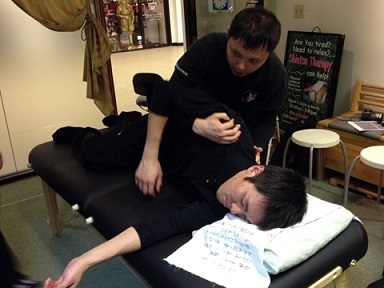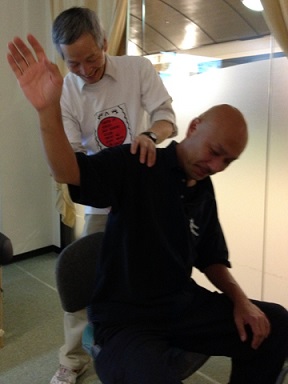| November 23rd, 2014, Continuing Professional Education Program, Jikiden-kai was held at Yaletown Clinic. |
| Topic: "Effective Table Shiatsu
Technique in Ouga Position-----for head/cervical area" (*Ouga means
lying on one's side) |
| Organizer: Makiko Participants: Atsushi, Ken, Mariko, Mirei, Misuzu, Nakako, Takahiro, Tom, Yasu and Yusuke F |
| It
was aimed to lead the participants to exchange opinions on the topic,
and to offer opportunity for sharing the technique and practicing. It started with a question "Do you often use Ouga position in your table Shiatsu treatment?", and only 3 out of 10 answered Yes. That shows there is less opportunity to use Ouga position in a limited treatment time. The first question lead to the next one: "What are the advantages of Ouga position?". We shared the answers as "effective for short necked or big clients","more relaxation for clients","easier to apply pressure for small therapists with less strength","more effective treatment on lateral/posterior cervical and occipital area" and so on. Then Makiko demonstrated head and neck treatment on Mariko in Ouga position. Treatment started from temporal area, then occipital to cervical, with introducing Tsubo points in each area and line. Following to Shaitsu demonstration, stretching technique was introduced and the demonstration was done by Tom who is very experienced in it. In the latter half, the participants were paired up and practiced. Searching better finger/hand positioning and stretching technique, everyone was very eagerly practicing. Some of participants' feedback; "I usually did not use Ouga position, but today I learned its effectiveness according to the symptoms and conditions" "Treatment on 5 lines instead of 3 lines in cervical area was more effective and satisfactory" " I would like to use this technique from tomorrow!" "I became more interested in learning Ouga, even on more points on other parts of the body." (Makiko)
|
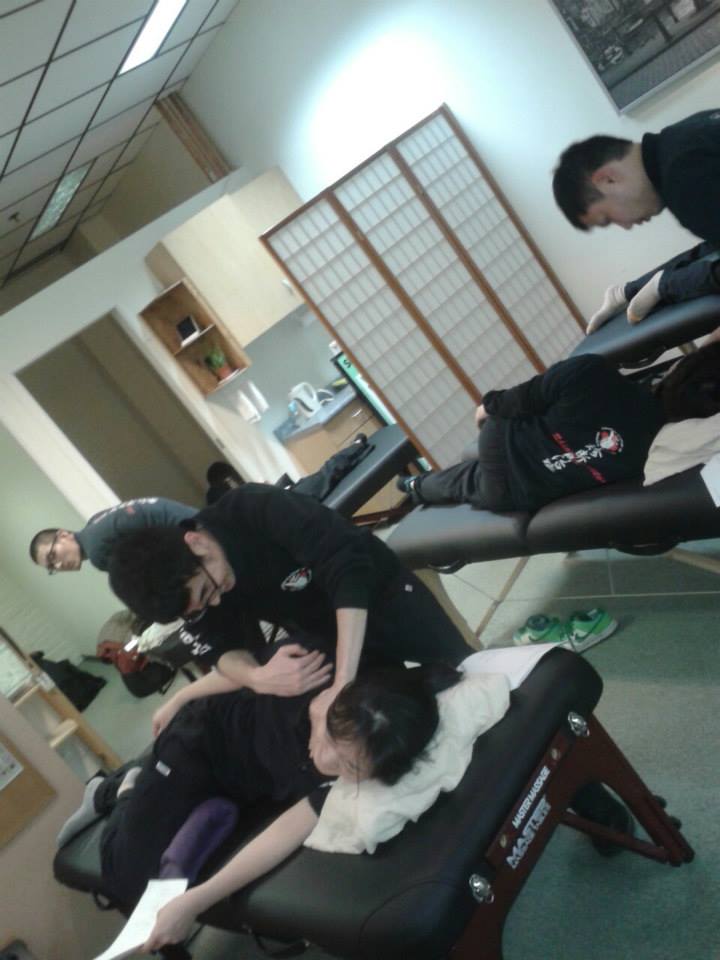 |
 |
 |
 |
 |
 |
 |
|
| September
13th, 2014, Continuing Professional Education Program, Jikiden-kai was
held at Canadian College of Shiatsu Therapy Main Campus. |
| Special guest: Tomoko Tanaka Sensei and Shiho Atari Sensei Participants: Kiyoshi, Hiroaki, Nakako, Atsushi, Misuzu, Mirei, Christina, Mariko, Masako, Yasu, Akiko, Yusuke S, Ayano and Kaz |
| We invited
Shiho Atari Sensei and Tomoko Tanaka Sensei from Japan Shiatsu College,
and had lectures about “The method of treatment around using Ching
muscle (muscles, tendons that follow the meridian line)” and “How to
treat dysmenorrheal (painful periods)”. We started with “The method of
treatment around using Ching muscle” by Atari Sensei. She instructed
the treatment plan from different angle of meridian lines, and it was
based on her own experiences. Next we had a lecture about “How to treat
dysmenorrheal” by Tanaka Sensei. She explained the major regions for
the treatment and the reasons why we work for, and show us how to apply
the pressure there. Then we made pairs and practice each other to get
the skills as much as we can. We could have a quality time with not only interesting topics but also the techniques/advices for the clients in bounded time. (Kaz)
|
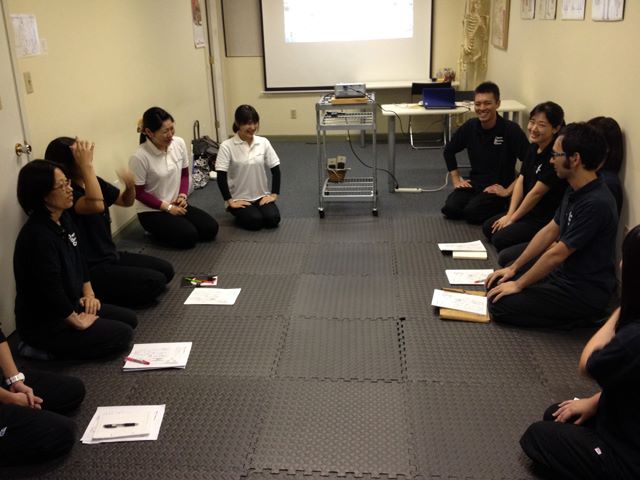 |
 |
 |
 |
 |
 |
 |
 |
 |
 |
 |
 |
| August 24th, 2014, Continuing Professional Education Program,
Jikiden-kai was held at Yaletown Clinic. |
| Participants: Kiyoshi, Ken, Misuzu, Mariko, Takahiro, Yasu,
Yusuke S and Kaz |
| We
watched the video about “Treatment for knee pain” by Shiatsumaster
Ueno Sensei, and studied for the treatment on Gyoga (lie down on the
back, the client can not lie down on the stomach/side). He showed how
to activate the blood circulation, applying the pressure from neck or
other area which associated to the knees. Then we tried to use these
techniques each other. I hope it was a good opportunity to be a part of their method for making treatment plan or their way of thinking. (Kaz)
|
 |
 |
 |
 |
 |
 |
 |
|
| July 20th, 2014, Continuing Professional Education Program,
Jikiden-kai was held at Yaletown Clinic. |
| Guest Speaker: Blandina Macasaet (instructor) Participants: Yusuke F, Makiko, Yusuke S, Takahiro, Mariko and Kaz |
| Continuation
of the Jikiden-kai held on May 18, 2014, Ms. Blandina, who is currently
the Kinesiology instructor at Canadian College of Shiatsu Therapy,
lectured us
on “Special Tests and Physical Assessment”. She demonstrated on Kaz
lower body testing. We grouped into pairs and
practiced on each other. Each group presented what they had learnt, and
instructed in great detail how to test on a client’s body. Many clients
ask for short treatment time, as therapists, we try to
gather as much information on their current condition, to be able to
provide a more effective and safe treatment plan. (Kaz)
|
 |
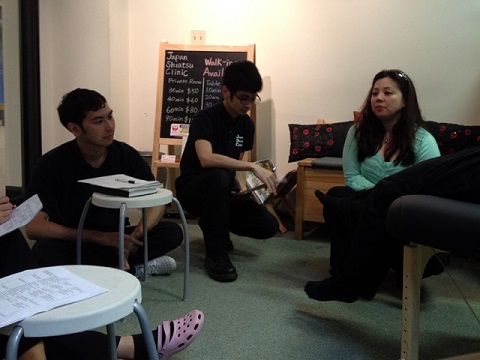 |
 |
 |
 |
 |
 |
 |
 |
 |
 |
 |
| June 22nd, 2014, Continuing Professional Education Program,
Jikiden-kai was held at Yaletown Clinic. |
| Participants: Kiyoshi, Hiroaki, Takahiro, Ken and Kaz |
| We
shared the treatment plan and feedback from same view point as
Shiatsupractor to give the treatment to him/her who had something wrong
on his/her body condition. No volunteer as “Guinea pig” this time,
however, Kiyoshi had a back issue for good or bad, we worked on
him and share the plan and feedback. Treatment plans were checking the
posture of pelvic area and make the treatment plan to focus on holding
pressure, whole body treatment especially focus on shoulder area and
elector spine muscles, and so on. Everybody got a good feedback from
Kiyoshi about different treatment plan or characteristics of
pressure. We keep working on this opportunity with “guinea pig” and brush up each other. (Kaz)
|
 |
 |
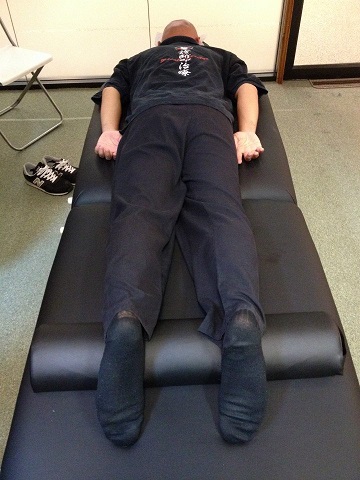 |
 |
 |
 |
 |
 |
| May 18th, 2014, Continuing Professional Education Program,
Jikiden-kai was held at Yaletown Clinic. |
| Guest Speaker: Blandina Macasaet (instructor) Participants: Mari, Ayano, Akiko, Makiko, Hiroaki, Mirei, Mariko, Masako, Shiro, Tom, Teruyo and Kaz |
| We
invited Ms. Blandina Macasaet, who is the Kinesiology instructor at
Canadian College of Shiatsu Therapy, and had a lecture for “Special
Tests and Physical Assessment”. Before showing the special tests, she described the procedures for the test and how to ask the questions. Then she demonstrated with precautions one by one. Each and all therapists got something from the lecture even the therapists already learnt “Special Tests” before because of different environment or language, etc. If we can identify the main cause about a decrease of ROM, pain or symptoms, we can give the treatment to the clients more effectively in their treatment time. All of us brace ourselves up and make the best effort for the treatments. We have gotten them for upper body, so we hope to have the same topic but for lower body near future. (Kaz)
|
| April 6th, 2014, Continuing Professional Eduation Program,
Jikiden-kai was held at Yaletown Clinic. |
| Special guest: Miyawaki Sensei Participants: Kiyoshi, Yusuke, Aimi, Kana, Atsushi, Nakako, Chika, Mirei, Ayano, Hiroaki and Kaz |
| We invited Toshihiro Miyawaki
Sensei from Argentina, and had a lecture about “Quick-effect of Seated
Shiatsu”. He explained the detail with watching the video first, then
we checked that which muscles moved when we rotate the shoulders, and
we exchanged and practiced how to treat each parts. The treatment was
about 10 minutes and it was covered shoulders, arms, neck and chest
area, however, that was really hard to do everything in 10 minutes. It
was more than enough value in 10 minutes. All of us practiced as long
as the time we had because even we learned the “Seated Shiatsu”, we
could also use these techniques to the floor/table Shiatsu, too. (Kaz)
|
| March 16th, 2014, Continuing Professional Eduation Program, Jikiden-kai was held at Canadian College of Shiatsu Therapy Main Campus. |
| Special guest: Ms. Yuko Ueda Participants: Mariko, Nakako, Makiko and Kaz |
| Ms. Yuko Ueda, who was a student
at Canadian College of Shiatsu Therapy, came from Japan and had a
lecture about “How important the education of mind is”. She explained
the difference between Mentorship, Counselling and Coaching, and the
judgement/action which was related by brain system. She also
reported us about current situation in Nepal with many pictures because
she went there last December with her teacher to have the same lecture
at ILO. This was not only for human resources in business, but
also for any other field we could use. They focused on taking
notes or asking questions, and really enjoyed each other. (Kaz)
|
 Started the lecture. |
 Concentrated on the interesting story. |
 Talking about brain system. |
 Taking a note for their own life, too. |
| February 16th, 2014, Continuing Professional Eduation
Program, Jikiden-kai was held at YWCA Hotel Royal Bank Room. |
| Special guest: Asada Sensei Participants: Kiyoshi, Yusuke, Aimi, Akiko, Kana, Makiko, Yukako, Atsushi, Miki, Shiro, Tomo and Kaz |
| We invited Hideo Asada Sensei,
who is the president of the Shiatsu Society of Mexico, and had a
lecture on “Practicing pain-free Shiatsu”. At first, he had a lecture for the different view point from Shiatsu, such as “cutaneovisceral reflexes”, “myotuning approach (similar to the gate control theory of pain) with dermatome”. Then, we practiced to find the point of gate control especially focused on the same or conterminous level of dermatome, and we also practiced to find the best position for the client to give the pressure for specific muscles such as IT band, bicep femoris, iliopsoas muscle, etc. All therapists studied earnestly to assimilate the knowledge and the skill for their own Shiatsu treatment. (Kaz)
|
| Message
from Asada Sensei During shiatsu treatment, patients often experience pain when pressure is applied to the area where their complaint originates. Proper regulation of pressure in such cases is said to depend on skill and experience, but it is possible, with the help of the four fingers, to effectively apply shiatsu to the area while causing little or no pain. This results in less physical and mental stress for the patient, making treatment more effective. |
 |
 |
 |
 |
 |
 |
 |
 |
 |
 |
 |
 |
 |
|
| January 19th, 2014, Continuing Professional Eduation Program,
Jikiden-kai was held at Japan Shiatsu Clinic in Metrotown. |
| Participants: Kiyoshi, Yusuke, Shiro, Aimi, Kana, Atsushi,
Tomo and Kaz |
| The
main topic was “Difference of treatment plan or point of view from the
length of pressure” and we planned to discuss about
advantages/disadvantages or types of pressure, then exchange Shiatsu;
however, we talked with “case-by-case” situation, things still remained
as unclear. Each therapist perceived Shiatsu as their own style and all of them were right, Kiyoshi said, and we realized again that the pressure, which we felt as quick, was almost same as usual but lose the numbers of point and covered more wide area. We found something new even we pressed normally before when we focused on each types of pressure. We would love to provide the Jikiden-kai as meaningful event for all therapists! (Kaz)
|
 |
 |
 |
 |
 |
 |














